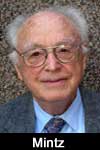Morton Mintz: Eliminating Nuclear Weapons Should Be More Than a Back Burner Issue for The Press
Posted at 6:42 pm, February 24th, 2007
“The goal of the eventual elimination of nuclear weapons has been essentially forgotten,” Mikhail Gorbachev wrote recently. “We must put the goal…back on the agenda, not in a distant future but as soon as possible.”
But over the past 15 years, he pointed out in a Wall Street Journal opinion piece on Jan. 31, the goal “has been so much on the back burner that it will take a true political breakthrough and major intellectual effort to achieve success in this endeavor.”
A poor press performance is one reason why the goal is on the back burner, although this went generously unmentioned by the former leader of the Soviet Union, who in 1985 joined Ronald Reagan in declaring that “a nuclear war cannot be won and must never be fought.”
I’ve deplored press non-performance on this subject redundantly—and without result—for nearly seven years, first in a piece for tompaine.com, then in two pieces for The American Prospect, and finally for Columbia Journalism Review. Here’s an excerpt from my CJR article, in the November/December 2005 issue:
The cold war is long over, and the United States and Russia are at peace. Yet together they have approximately 4,000 nuclear warheads on hair-trigger alert – weapons with a combined destructive power nearly 100,000 times that of the atomic bomb that leveled Hiroshima are armed and fueled at all times. Their targets – Washington and New York, Moscow and St. Petersburg – have been programmed by internal computers. In the U.S., they will launch on receiving three computer-delivered messages. Launch crews – on duty 24-7 – will send the messages on receipt of a single computer-delivered command.
On May 23, 2000, presidential candidate George W. Bush embraced National Missile Defense in a speech in Washington. The mainstream press reported this. In the same speech, however, Bush also said: “The United States should remove as many weapons as possible from high-alert, hair-trigger status – another unnecessary vestige of cold war confrontation . . . For two nations at peace, keeping so many weapons on high alert may create unacceptable risks of accidental or unauthorized launch. So, as president, I will ask for an assessment of what we can safely do to lower the alert status of our forces.”
Bush’s commitment to Star Wars was utterly predictable. His concern about “unacceptable risks of accidental or unauthorized launch” was a highly newsworthy surprise. For one thing, Bush was implicitly repudiating the longstanding acceptance of the status quo by his fellow Republicans in Congress. For another, he was taking the lead on an issue that President Bill Clinton and the Democratic presidential candidate Al Gore had ignored. The mainstream press told voters none of this.
The neglect of candidate Bush’s stand on high-alert nuclear weapons would prove to be only a prologue to five years of sustained journalistic neglect of the issue. Here are highlights of what the press ignored:
Bush did in fact request the assessment, or nuclear-posture review, and received it in early 2002. Soon thereafter, the president reversed the course he’d set as a candidate, accepting upon entering the White House the very risks he’d found “unacceptable” while campaigning. Bruce G. Blair, who heads the World Security Institute and is widely considered the nation’s foremost authority on nuclear command and control, and others at the institute have warned frequently that ready-to-fire nuclear weapons are susceptible to unauthorized launch by heavily armed terrorists, who might either capture a missile or electronically hack into a missile launch control system. In 2002, for example, Blair cited a “super-secret Pentagon study” that concluded that terrorists could hack the U.S. submarine communications network and “actually transmit a launch order to the Trident fleet.” Two years and a day after his Washington speech, President Bush and Prime Minister Vladimir V. Putin of Russia signed the Moscow Treaty on Strategic Offensive Reductions. But they were silent about the thousands of warheads on hair-trigger alert. The press was silent about the silence. Nor did it remind the public of candidate Bush’s view that too many warheads were ready to fire. Two months after Bush and Putin met in Moscow, the Senate Foreign Relations Committee held a hearing on the treaty. Two longtime experts on strategic nuclear arms, former Senator Sam Nunn, co-chairman of the Nuclear Threat Initiative, and Eugene Habiger, former commander in chief of the Strategic Command, testified. Nunn said that progress toward removing weapons from higher alert status “may well be more important to stability and security than the number of nuclear weapons.” Habiger warned, “There is only one thing that can destroy the United States of America today – and that is Russian nuclear warheads.” Major news organizations reported the testimony of neither Nunn nor Habiger. All this information was readily available to journalists, if not always staring them in the face. NBC’s Tim Russert recognized the peril by making “the threat and prevention of nuclear terrorism” the subject of Meet the Press on May 29, 2005. Among Russert’s guests that day were Sam Nunn and Richard Lugar, chairman of the Senate Foreign Relations Committee, who co-authored the Nunn-Lugar Cooperative Threat Reduction Program.




